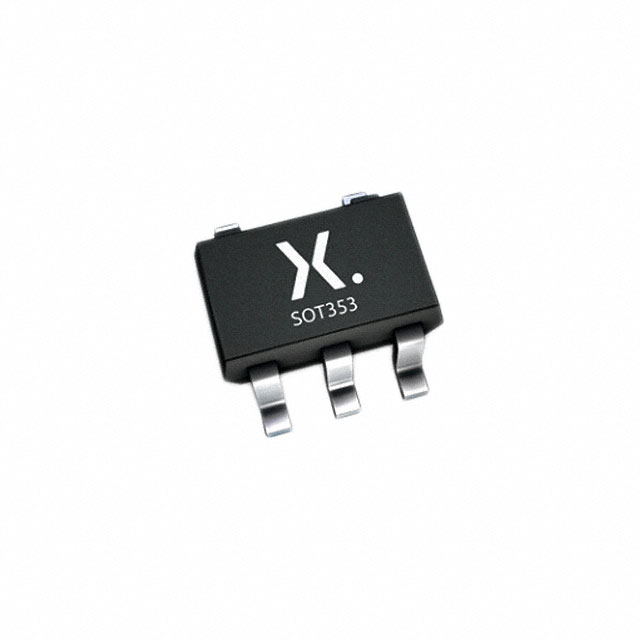Xem thông số kỹ thuật để biết chi tiết sản phẩm.

74HC1G86GW,165
Basic Information Overview
- Category: Integrated Circuit (IC)
- Use: Logic Gate
- Characteristics: Single 2-input XOR gate
- Package: SOT353 (SC-88A)
- Essence: High-speed CMOS technology
- Packaging/Quantity: Tape and Reel, 3000 pieces per reel
Specifications
- Supply Voltage Range: 2.0V to 6.0V
- Input Voltage Range: GND to VCC
- Output Voltage Range: GND to VCC
- Operating Temperature Range: -40°C to +125°C
- Propagation Delay: 5 ns (typical) at 4.5V
- Maximum Quiescent Current: 1 µA at 5.5V
Detailed Pin Configuration
The 74HC1G86GW,165 has a total of 5 pins: 1. A Input 2. B Input 3. Y Output 4. GND (Ground) 5. VCC (Supply Voltage)
Functional Features
- High-speed operation: The 74HC1G86GW,165 is designed using high-speed CMOS technology, allowing for fast switching times.
- Low power consumption: With a maximum quiescent current of only 1 µA, this IC is highly efficient in terms of power usage.
- Wide supply voltage range: It can operate within a supply voltage range of 2.0V to 6.0V, providing flexibility in various applications.
- Compact package: The SOT353 package (also known as SC-88A) offers a small footprint, making it suitable for space-constrained designs.
Advantages and Disadvantages
Advantages: - High-speed operation enables quick signal processing. - Low power consumption prolongs battery life in portable devices. - Wide supply voltage range allows for compatibility with different power sources. - Compact package saves board space in tight designs.
Disadvantages: - Limited to a single 2-input XOR gate, limiting its functionality compared to more complex logic ICs. - Not suitable for applications requiring multiple logic gates or complex logic functions.
Working Principles
The 74HC1G86GW,165 is a XOR (exclusive OR) gate, which produces a high output only when the number of high inputs is odd. It operates by comparing the logical states of its two input pins (A and B) and generating an output signal (Y) accordingly. The XOR gate follows the truth table:
| A | B | Y | |---|---|---| | 0 | 0 | 0 | | 0 | 1 | 1 | | 1 | 0 | 1 | | 1 | 1 | 0 |
Detailed Application Field Plans
The 74HC1G86GW,165 can be used in various applications, including but not limited to: - Digital communication systems - Data encryption and decryption - Error detection and correction circuits - Arithmetic operations in microprocessors - Control systems and automation
Detailed and Complete Alternative Models
Some alternative models that offer similar functionality to the 74HC1G86GW,165 include: - SN74LVC1G86DBVR (Texas Instruments) - MC74VHC1G86DF (ON Semiconductor) - CD74HCT86E (Texas Instruments) - NC7SZ86P5X (Fairchild Semiconductor)
These alternatives provide similar XOR gate functionality and are available in different packages, allowing designers to choose the most suitable option for their specific requirements.
In conclusion, the 74HC1G86GW,165 is a single 2-input XOR gate integrated circuit. Its high-speed operation, low power consumption, and wide supply voltage range make it suitable for various applications. However, its limited functionality compared to more complex logic ICs should be considered. Alternative models are available to provide similar XOR gate functionality in different package options.
Liệt kê 10 câu hỏi và câu trả lời thường gặp liên quan đến ứng dụng 74HC1G86GW,165 trong giải pháp kỹ thuật
Sure! Here are 10 common questions and answers related to the application of 74HC1G86GW and 74HC165 in technical solutions:
1. What is the function of the 74HC1G86GW? The 74HC1G86GW is a single 2-input XOR gate, which means it performs an exclusive OR operation on two input signals.
2. What is the function of the 74HC165? The 74HC165 is an 8-bit parallel-in/serial-out shift register. It allows you to read multiple digital inputs using only a few microcontroller pins.
3. Can I use multiple 74HC1G86GW gates together? Yes, you can connect multiple 74HC1G86GW gates together to perform XOR operations on more than two inputs.
4. How do I connect the 74HC165 to my microcontroller? The 74HC165 requires connections for clock (CLK), data (SER), and parallel load (PL) signals. Additionally, you need to connect the output pins (Q0-Q7) to your microcontroller's input pins.
5. What is the maximum clock frequency for the 74HC165? The maximum clock frequency for the 74HC165 is typically around 25 MHz, but it may vary depending on the specific datasheet and operating conditions.
6. Can I daisy-chain multiple 74HC165s together? Yes, you can daisy-chain multiple 74HC165s by connecting the serial output (Q7) of one chip to the serial input (SER) of the next chip. This allows you to read even more inputs using the same number of microcontroller pins.
7. What is the power supply voltage range for both ICs? Both the 74HC1G86GW and 74HC165 typically operate with a power supply voltage range of 2V to 6V.
8. Are these ICs compatible with both CMOS and TTL logic levels? Yes, both the 74HC1G86GW and 74HC165 are compatible with both CMOS and TTL logic levels, making them versatile for various applications.
9. Can I use the 74HC165 to read analog signals? No, the 74HC165 is designed to read digital signals only. If you need to read analog signals, you would require an analog-to-digital converter (ADC) in your circuit.
10. Are there any specific precautions I should take when using these ICs? Some general precautions include avoiding excessive heat, ensuring proper decoupling capacitors are used, and following the recommended operating conditions mentioned in the datasheets. Additionally, it's important to handle the ICs properly to prevent electrostatic discharge (ESD) damage.
Please note that these answers are general and may vary depending on the specific datasheet and application requirements.

